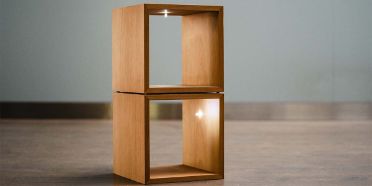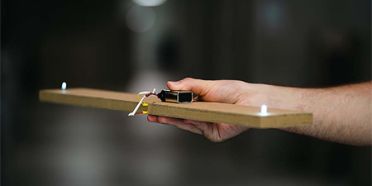CoPaCabANi: Feasibility study for low-current conductive wood-based panels
Integrating lighting into furniture seems straightforward enough, but to do so without any wiring calls for a completely new solution. This is precisely what the ‘CoPaCabANi’ project is all about: developing conductive furniture panels.
Factsheet
- Lead school School of Architecture, Wood and Civil Engineering
- Institute Institute for Building Materials and Biobased Products IBBM
- Research unit Materials and Life Cycle Assessment group FGWO
- Funding organisation Innosuisse
- Duration 03.08.2020 - 08.01.2024
- Project management Prof. Dr. Heiko Thömen
- Head of project Christof Tschannen
-
Project staff
Christof Tschannen
Prof. Dr. Heiko Thömen
Dr. Ali Shalbafan - Keywords Wood-based materials; furniture, lighting; wireless conductivity
Situation
Contemporary furniture is hard to imagine without the integration of electronic components. But this also means new solutions need to be found for wiring in furniture. The Conductive Particleboard for Cabinets At Night (CoPaCabANi) project aims to supply electronic components with power without using wiring. The key principles of this approach were established in BFH’s ‘Smart Electronic Furniture’ project, which includes the concept of conductive panels. The wireless power supply of LED lighting, for example, opens up completely new and hitherto unknown possibilities for interior lighting or the illumination of furniture or wood surfaces and their role in design. The use of conductive panels makes the installation of LED lighting and other electronic components highly flexible, cable-free and cost-effective. This feasibility study covers key aspects of process engineering, material properties and production costs. It focuses on developing the conductive panels and their properties to provide a decision-making basis for further technology development with implementation partners.
Course of action
Standard wood-based panels do not conduct electricity. A small amount of conductive material must be added to panels to enable electrical conductivity. The predecessor project used carbon fibres for this purpose. In an initial stage, the project will now explore whether other additives can also be used to produce conductive panels. In a next stage, the panels will be developed using the new additives selected to achieve optimal conductivity using the minimum amount of additive. During the previous concept study problems were encountered achieving a homogeneous mixture of wood chippings and carbon fibres, which impacted on the panel surface, the appearance of the panel and its processability, e.g. coating. After the successful development of the conductive panel, the focus will shift to processing. Researchers will aim to establish whether the improvements to the panel resolve the issues faced or whether other reasons exist for poor processability. The goal is to develop and manufacture a demonstration product by the end of the project. The economic and ecological impact of the development will be evaluated in parallel. The study will place particular emphasis on options for recycling the panels or their individual components, resulting in a recycling concept for conductive wood-based panels.
Result
Even after the analysis of other additives, carbon fibres still produce the best results for improving conductivity in wood-based materials. A process has been developed which enables the creation of an almost perfectly homogeneous mixture of wood chippings/fibres and carbon fibres. Due to the improved mixing, the proportion of carbon fibres could also be significantly reduced. Although fewer carbon fibres are used, the conductance is at least as good as before and, in some cases, even better than in the concept study. To guarantee good further processing, the structure of the board was changed. Previously, a 3-layer layering of the materials was used. The optimised board consists of five layers, whereby the outer layers correspond to the surface of conventional wood-based materials. In the process, not more material was used overall, but rather the materials were distributed differently. The proportion of carbon fibres could be further reduced, as the conductive layer per layer is now only approx. 1.5 mm thick. Overall, the proportion of carbon fibres in relation to the wood mass was reduced to less than 1 % with significantly better conductivity compared to the concept study. A demonstration object was made from the panels. The surfaces of the panel could be coated with veneer and the lighting in the furniture works perfectly without cables. A concept for the recyclability of the panels was also developed.
Looking ahead
The low-current conductive furniture panels and an LED connector for triple-layer panels developed by us have meanwhile been registered for patent. If the feasibility study is successful, it is planned to further develop the product or idea to market maturity together with an implementation partner. In the current feasibility study, discussions have already been held with possible partners both in Switzerland and internationally. There is great interest on the part of the furniture and furniture supply industry.


